Strategic Marketing Report
VerifiedAdded on 2020/02/14
|17
|5255
|90
Report
AI Summary
This report provides a comprehensive analysis of strategic marketing for Total Marketing Solutions (TMS). It examines the role of strategic marketing within TMS, the relationship between corporate and marketing strategies, and the development of a marketing strategy. The report includes an internal and external environmental analysis, integrating both perspectives using a SWOT analysis. Various competitive positioning approaches are explored, along with marketing communication strategies and resource management implications. The report concludes by summarizing key findings and recommendations for TMS to gain a competitive advantage.
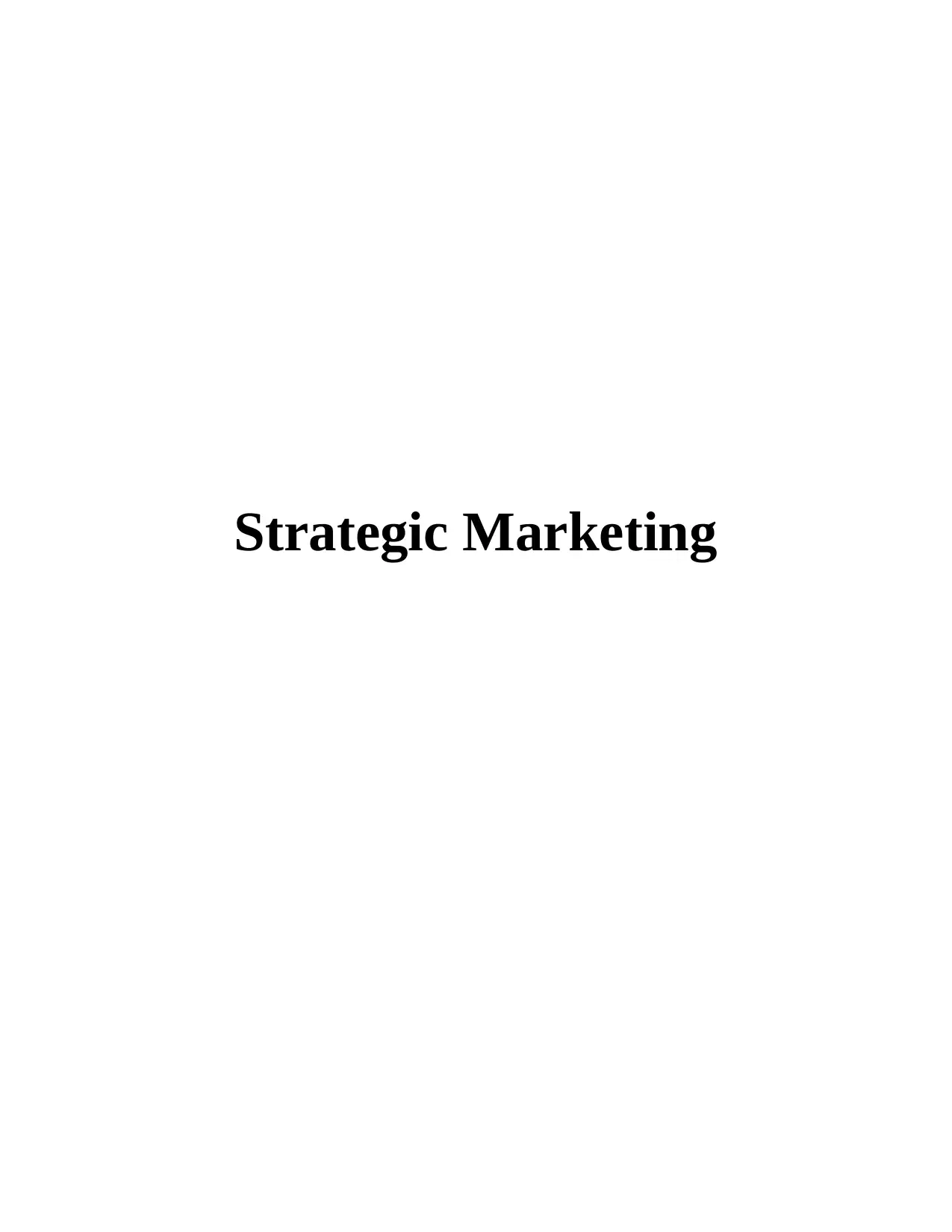
Strategic Marketing
Paraphrase This Document
Need a fresh take? Get an instant paraphrase of this document with our AI Paraphraser
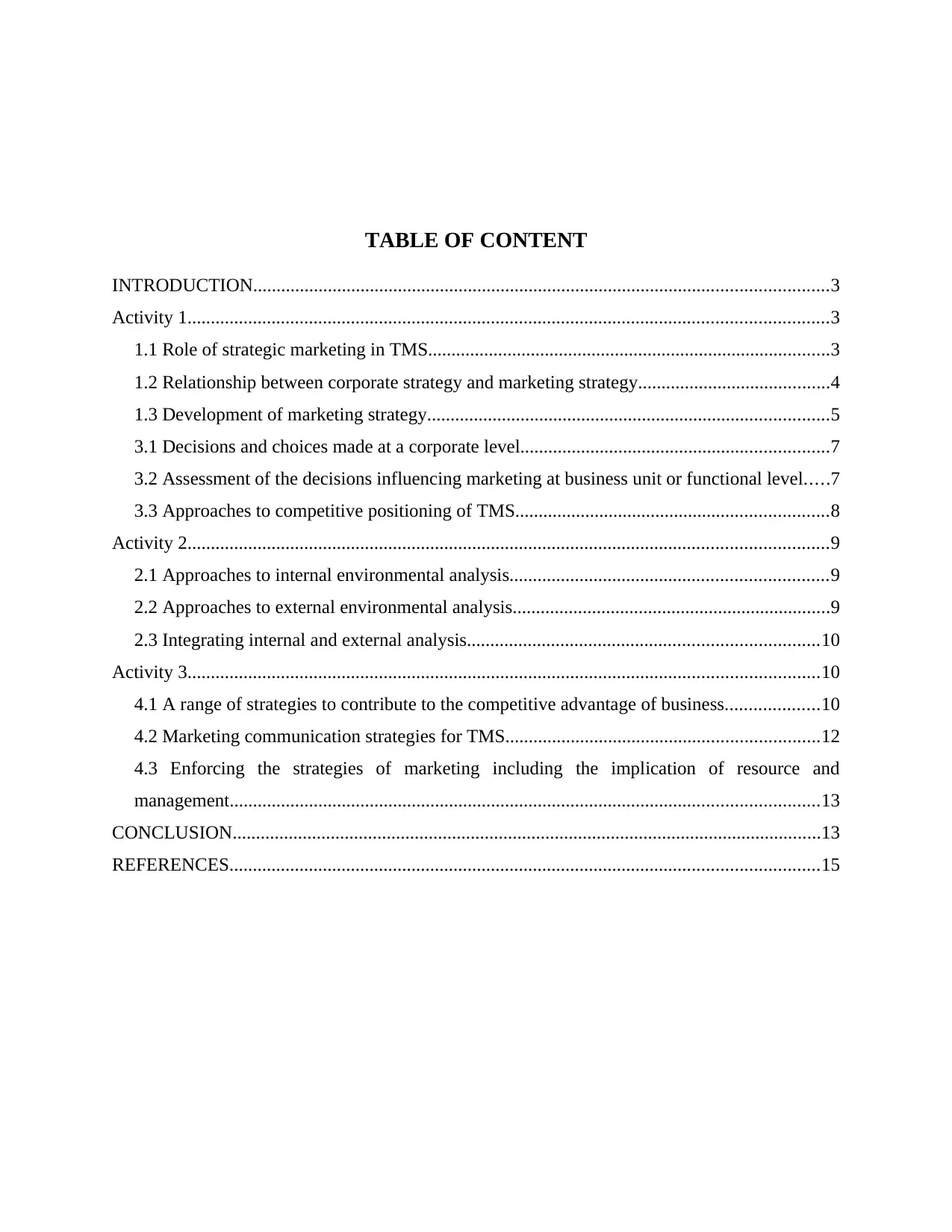
TABLE OF CONTENT
INTRODUCTION...........................................................................................................................3
Activity 1.........................................................................................................................................3
1.1 Role of strategic marketing in TMS......................................................................................3
1.2 Relationship between corporate strategy and marketing strategy.........................................4
1.3 Development of marketing strategy......................................................................................5
3.1 Decisions and choices made at a corporate level..................................................................7
3.2 Assessment of the decisions influencing marketing at business unit or functional level.....7
3.3 Approaches to competitive positioning of TMS...................................................................8
Activity 2.........................................................................................................................................9
2.1 Approaches to internal environmental analysis....................................................................9
2.2 Approaches to external environmental analysis....................................................................9
2.3 Integrating internal and external analysis...........................................................................10
Activity 3.......................................................................................................................................10
4.1 A range of strategies to contribute to the competitive advantage of business....................10
4.2 Marketing communication strategies for TMS...................................................................12
4.3 Enforcing the strategies of marketing including the implication of resource and
management..............................................................................................................................13
CONCLUSION..............................................................................................................................13
REFERENCES..............................................................................................................................15
INTRODUCTION...........................................................................................................................3
Activity 1.........................................................................................................................................3
1.1 Role of strategic marketing in TMS......................................................................................3
1.2 Relationship between corporate strategy and marketing strategy.........................................4
1.3 Development of marketing strategy......................................................................................5
3.1 Decisions and choices made at a corporate level..................................................................7
3.2 Assessment of the decisions influencing marketing at business unit or functional level.....7
3.3 Approaches to competitive positioning of TMS...................................................................8
Activity 2.........................................................................................................................................9
2.1 Approaches to internal environmental analysis....................................................................9
2.2 Approaches to external environmental analysis....................................................................9
2.3 Integrating internal and external analysis...........................................................................10
Activity 3.......................................................................................................................................10
4.1 A range of strategies to contribute to the competitive advantage of business....................10
4.2 Marketing communication strategies for TMS...................................................................12
4.3 Enforcing the strategies of marketing including the implication of resource and
management..............................................................................................................................13
CONCLUSION..............................................................................................................................13
REFERENCES..............................................................................................................................15
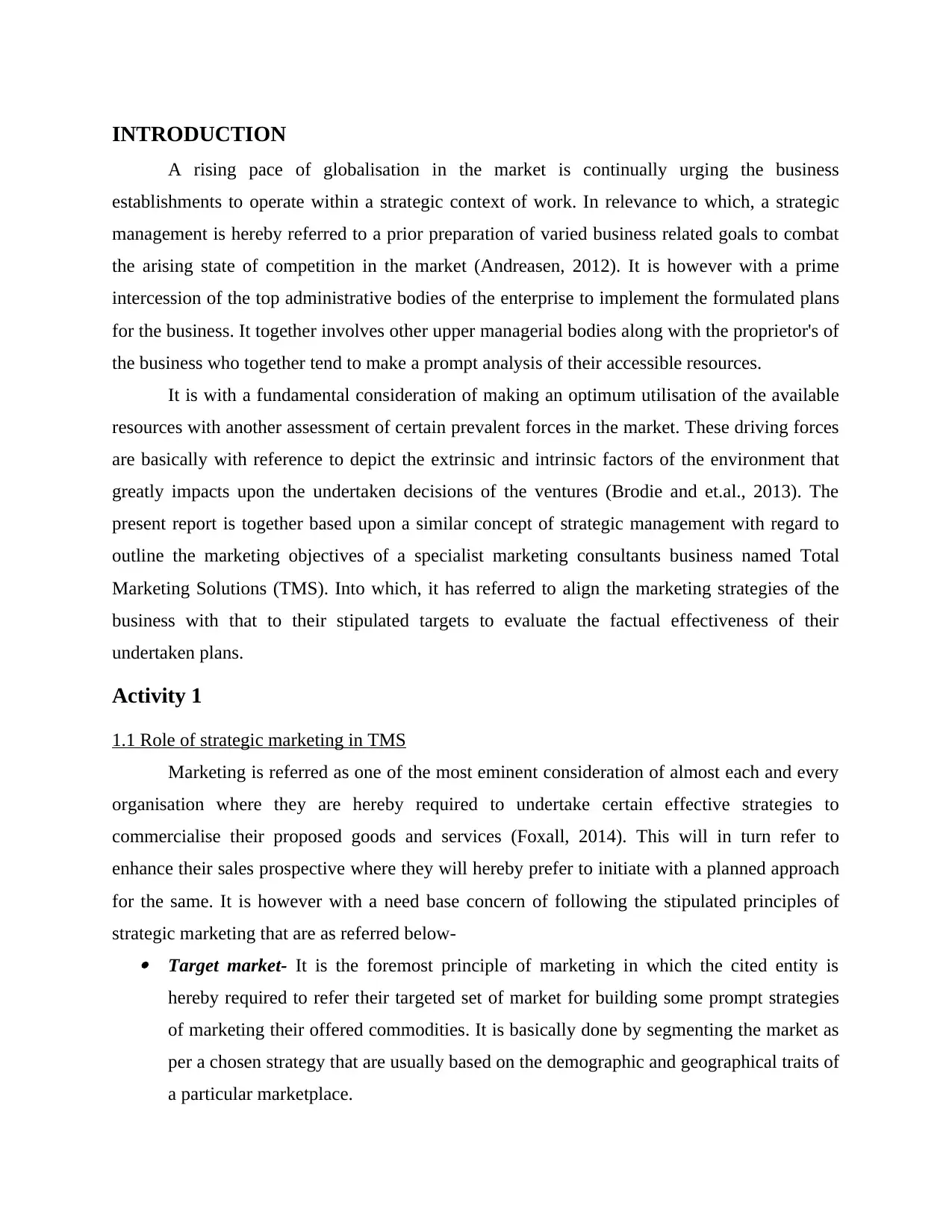
INTRODUCTION
A rising pace of globalisation in the market is continually urging the business
establishments to operate within a strategic context of work. In relevance to which, a strategic
management is hereby referred to a prior preparation of varied business related goals to combat
the arising state of competition in the market (Andreasen, 2012). It is however with a prime
intercession of the top administrative bodies of the enterprise to implement the formulated plans
for the business. It together involves other upper managerial bodies along with the proprietor's of
the business who together tend to make a prompt analysis of their accessible resources.
It is with a fundamental consideration of making an optimum utilisation of the available
resources with another assessment of certain prevalent forces in the market. These driving forces
are basically with reference to depict the extrinsic and intrinsic factors of the environment that
greatly impacts upon the undertaken decisions of the ventures (Brodie and et.al., 2013). The
present report is together based upon a similar concept of strategic management with regard to
outline the marketing objectives of a specialist marketing consultants business named Total
Marketing Solutions (TMS). Into which, it has referred to align the marketing strategies of the
business with that to their stipulated targets to evaluate the factual effectiveness of their
undertaken plans.
Activity 1
1.1 Role of strategic marketing in TMS
Marketing is referred as one of the most eminent consideration of almost each and every
organisation where they are hereby required to undertake certain effective strategies to
commercialise their proposed goods and services (Foxall, 2014). This will in turn refer to
enhance their sales prospective where they will hereby prefer to initiate with a planned approach
for the same. It is however with a need base concern of following the stipulated principles of
strategic marketing that are as referred below- Target market- It is the foremost principle of marketing in which the cited entity is
hereby required to refer their targeted set of market for building some prompt strategies
of marketing their offered commodities. It is basically done by segmenting the market as
per a chosen strategy that are usually based on the demographic and geographical traits of
a particular marketplace.
A rising pace of globalisation in the market is continually urging the business
establishments to operate within a strategic context of work. In relevance to which, a strategic
management is hereby referred to a prior preparation of varied business related goals to combat
the arising state of competition in the market (Andreasen, 2012). It is however with a prime
intercession of the top administrative bodies of the enterprise to implement the formulated plans
for the business. It together involves other upper managerial bodies along with the proprietor's of
the business who together tend to make a prompt analysis of their accessible resources.
It is with a fundamental consideration of making an optimum utilisation of the available
resources with another assessment of certain prevalent forces in the market. These driving forces
are basically with reference to depict the extrinsic and intrinsic factors of the environment that
greatly impacts upon the undertaken decisions of the ventures (Brodie and et.al., 2013). The
present report is together based upon a similar concept of strategic management with regard to
outline the marketing objectives of a specialist marketing consultants business named Total
Marketing Solutions (TMS). Into which, it has referred to align the marketing strategies of the
business with that to their stipulated targets to evaluate the factual effectiveness of their
undertaken plans.
Activity 1
1.1 Role of strategic marketing in TMS
Marketing is referred as one of the most eminent consideration of almost each and every
organisation where they are hereby required to undertake certain effective strategies to
commercialise their proposed goods and services (Foxall, 2014). This will in turn refer to
enhance their sales prospective where they will hereby prefer to initiate with a planned approach
for the same. It is however with a need base concern of following the stipulated principles of
strategic marketing that are as referred below- Target market- It is the foremost principle of marketing in which the cited entity is
hereby required to refer their targeted set of market for building some prompt strategies
of marketing their offered commodities. It is basically done by segmenting the market as
per a chosen strategy that are usually based on the demographic and geographical traits of
a particular marketplace.
⊘ This is a preview!⊘
Do you want full access?
Subscribe today to unlock all pages.

Trusted by 1+ million students worldwide
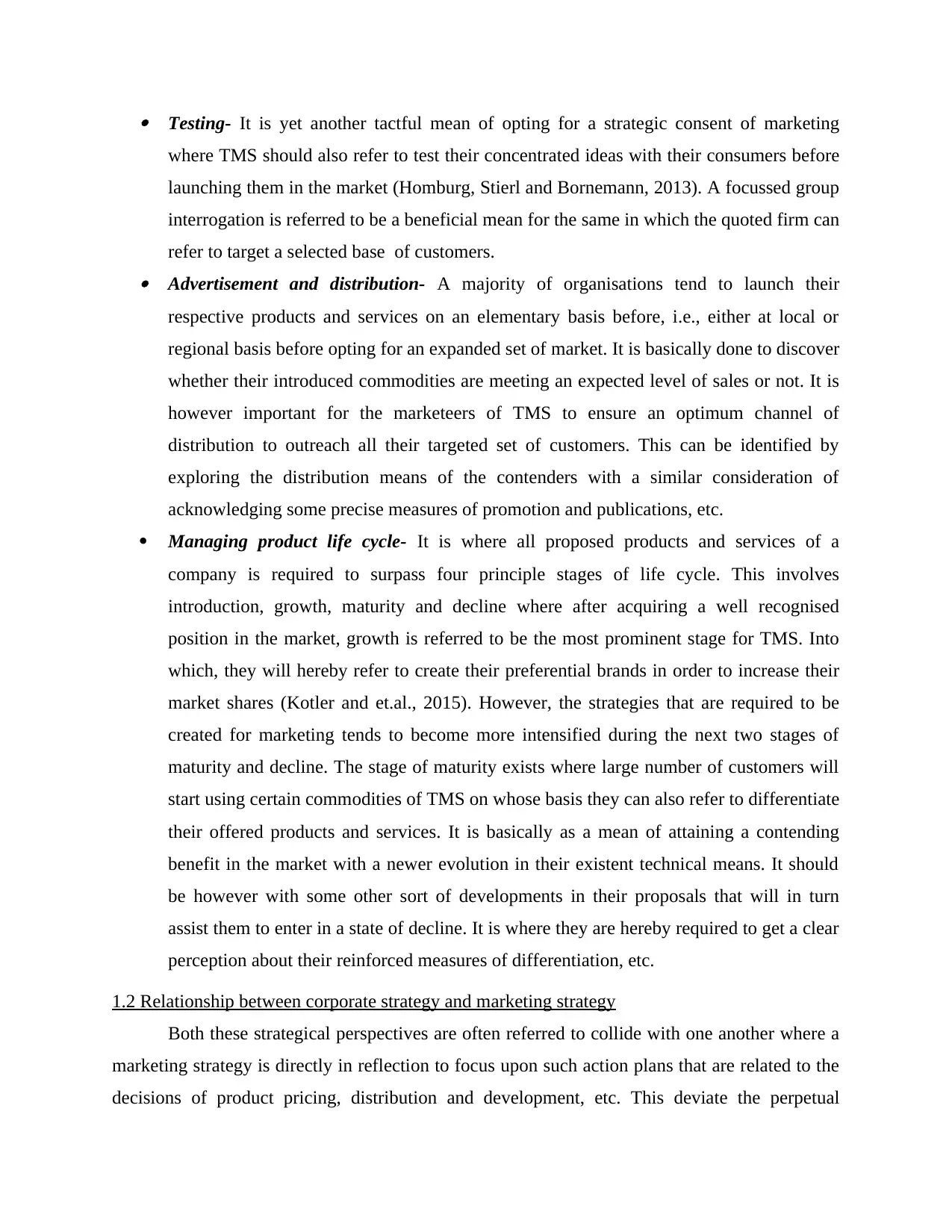
Testing- It is yet another tactful mean of opting for a strategic consent of marketing
where TMS should also refer to test their concentrated ideas with their consumers before
launching them in the market (Homburg, Stierl and Bornemann, 2013). A focussed group
interrogation is referred to be a beneficial mean for the same in which the quoted firm can
refer to target a selected base of customers. Advertisement and distribution- A majority of organisations tend to launch their
respective products and services on an elementary basis before, i.e., either at local or
regional basis before opting for an expanded set of market. It is basically done to discover
whether their introduced commodities are meeting an expected level of sales or not. It is
however important for the marketeers of TMS to ensure an optimum channel of
distribution to outreach all their targeted set of customers. This can be identified by
exploring the distribution means of the contenders with a similar consideration of
acknowledging some precise measures of promotion and publications, etc.
Managing product life cycle- It is where all proposed products and services of a
company is required to surpass four principle stages of life cycle. This involves
introduction, growth, maturity and decline where after acquiring a well recognised
position in the market, growth is referred to be the most prominent stage for TMS. Into
which, they will hereby refer to create their preferential brands in order to increase their
market shares (Kotler and et.al., 2015). However, the strategies that are required to be
created for marketing tends to become more intensified during the next two stages of
maturity and decline. The stage of maturity exists where large number of customers will
start using certain commodities of TMS on whose basis they can also refer to differentiate
their offered products and services. It is basically as a mean of attaining a contending
benefit in the market with a newer evolution in their existent technical means. It should
be however with some other sort of developments in their proposals that will in turn
assist them to enter in a state of decline. It is where they are hereby required to get a clear
perception about their reinforced measures of differentiation, etc.
1.2 Relationship between corporate strategy and marketing strategy
Both these strategical perspectives are often referred to collide with one another where a
marketing strategy is directly in reflection to focus upon such action plans that are related to the
decisions of product pricing, distribution and development, etc. This deviate the perpetual
where TMS should also refer to test their concentrated ideas with their consumers before
launching them in the market (Homburg, Stierl and Bornemann, 2013). A focussed group
interrogation is referred to be a beneficial mean for the same in which the quoted firm can
refer to target a selected base of customers. Advertisement and distribution- A majority of organisations tend to launch their
respective products and services on an elementary basis before, i.e., either at local or
regional basis before opting for an expanded set of market. It is basically done to discover
whether their introduced commodities are meeting an expected level of sales or not. It is
however important for the marketeers of TMS to ensure an optimum channel of
distribution to outreach all their targeted set of customers. This can be identified by
exploring the distribution means of the contenders with a similar consideration of
acknowledging some precise measures of promotion and publications, etc.
Managing product life cycle- It is where all proposed products and services of a
company is required to surpass four principle stages of life cycle. This involves
introduction, growth, maturity and decline where after acquiring a well recognised
position in the market, growth is referred to be the most prominent stage for TMS. Into
which, they will hereby refer to create their preferential brands in order to increase their
market shares (Kotler and et.al., 2015). However, the strategies that are required to be
created for marketing tends to become more intensified during the next two stages of
maturity and decline. The stage of maturity exists where large number of customers will
start using certain commodities of TMS on whose basis they can also refer to differentiate
their offered products and services. It is basically as a mean of attaining a contending
benefit in the market with a newer evolution in their existent technical means. It should
be however with some other sort of developments in their proposals that will in turn
assist them to enter in a state of decline. It is where they are hereby required to get a clear
perception about their reinforced measures of differentiation, etc.
1.2 Relationship between corporate strategy and marketing strategy
Both these strategical perspectives are often referred to collide with one another where a
marketing strategy is directly in reflection to focus upon such action plans that are related to the
decisions of product pricing, distribution and development, etc. This deviate the perpetual
Paraphrase This Document
Need a fresh take? Get an instant paraphrase of this document with our AI Paraphraser
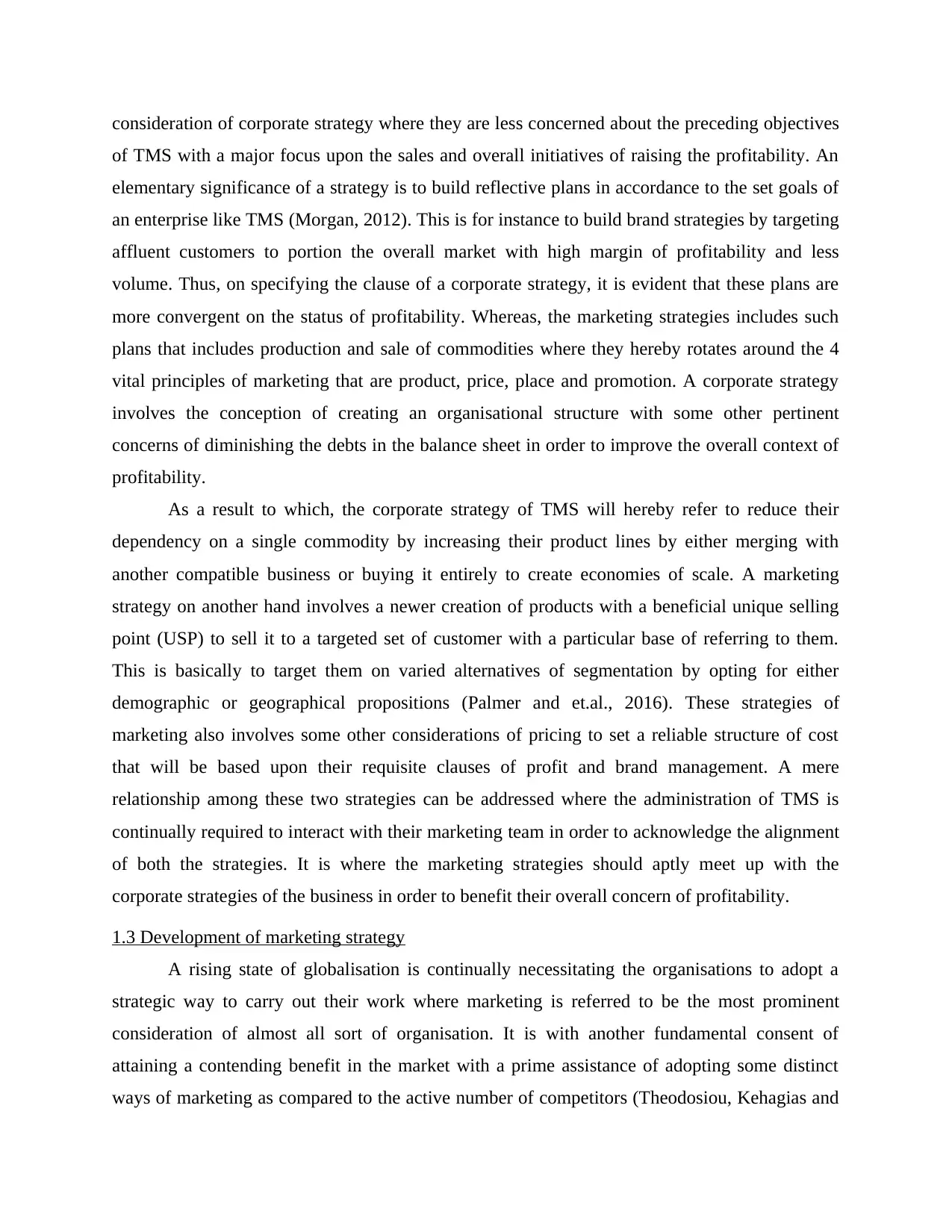
consideration of corporate strategy where they are less concerned about the preceding objectives
of TMS with a major focus upon the sales and overall initiatives of raising the profitability. An
elementary significance of a strategy is to build reflective plans in accordance to the set goals of
an enterprise like TMS (Morgan, 2012). This is for instance to build brand strategies by targeting
affluent customers to portion the overall market with high margin of profitability and less
volume. Thus, on specifying the clause of a corporate strategy, it is evident that these plans are
more convergent on the status of profitability. Whereas, the marketing strategies includes such
plans that includes production and sale of commodities where they hereby rotates around the 4
vital principles of marketing that are product, price, place and promotion. A corporate strategy
involves the conception of creating an organisational structure with some other pertinent
concerns of diminishing the debts in the balance sheet in order to improve the overall context of
profitability.
As a result to which, the corporate strategy of TMS will hereby refer to reduce their
dependency on a single commodity by increasing their product lines by either merging with
another compatible business or buying it entirely to create economies of scale. A marketing
strategy on another hand involves a newer creation of products with a beneficial unique selling
point (USP) to sell it to a targeted set of customer with a particular base of referring to them.
This is basically to target them on varied alternatives of segmentation by opting for either
demographic or geographical propositions (Palmer and et.al., 2016). These strategies of
marketing also involves some other considerations of pricing to set a reliable structure of cost
that will be based upon their requisite clauses of profit and brand management. A mere
relationship among these two strategies can be addressed where the administration of TMS is
continually required to interact with their marketing team in order to acknowledge the alignment
of both the strategies. It is where the marketing strategies should aptly meet up with the
corporate strategies of the business in order to benefit their overall concern of profitability.
1.3 Development of marketing strategy
A rising state of globalisation is continually necessitating the organisations to adopt a
strategic way to carry out their work where marketing is referred to be the most prominent
consideration of almost all sort of organisation. It is with another fundamental consent of
attaining a contending benefit in the market with a prime assistance of adopting some distinct
ways of marketing as compared to the active number of competitors (Theodosiou, Kehagias and
of TMS with a major focus upon the sales and overall initiatives of raising the profitability. An
elementary significance of a strategy is to build reflective plans in accordance to the set goals of
an enterprise like TMS (Morgan, 2012). This is for instance to build brand strategies by targeting
affluent customers to portion the overall market with high margin of profitability and less
volume. Thus, on specifying the clause of a corporate strategy, it is evident that these plans are
more convergent on the status of profitability. Whereas, the marketing strategies includes such
plans that includes production and sale of commodities where they hereby rotates around the 4
vital principles of marketing that are product, price, place and promotion. A corporate strategy
involves the conception of creating an organisational structure with some other pertinent
concerns of diminishing the debts in the balance sheet in order to improve the overall context of
profitability.
As a result to which, the corporate strategy of TMS will hereby refer to reduce their
dependency on a single commodity by increasing their product lines by either merging with
another compatible business or buying it entirely to create economies of scale. A marketing
strategy on another hand involves a newer creation of products with a beneficial unique selling
point (USP) to sell it to a targeted set of customer with a particular base of referring to them.
This is basically to target them on varied alternatives of segmentation by opting for either
demographic or geographical propositions (Palmer and et.al., 2016). These strategies of
marketing also involves some other considerations of pricing to set a reliable structure of cost
that will be based upon their requisite clauses of profit and brand management. A mere
relationship among these two strategies can be addressed where the administration of TMS is
continually required to interact with their marketing team in order to acknowledge the alignment
of both the strategies. It is where the marketing strategies should aptly meet up with the
corporate strategies of the business in order to benefit their overall concern of profitability.
1.3 Development of marketing strategy
A rising state of globalisation is continually necessitating the organisations to adopt a
strategic way to carry out their work where marketing is referred to be the most prominent
consideration of almost all sort of organisation. It is with another fundamental consent of
attaining a contending benefit in the market with a prime assistance of adopting some distinct
ways of marketing as compared to the active number of competitors (Theodosiou, Kehagias and
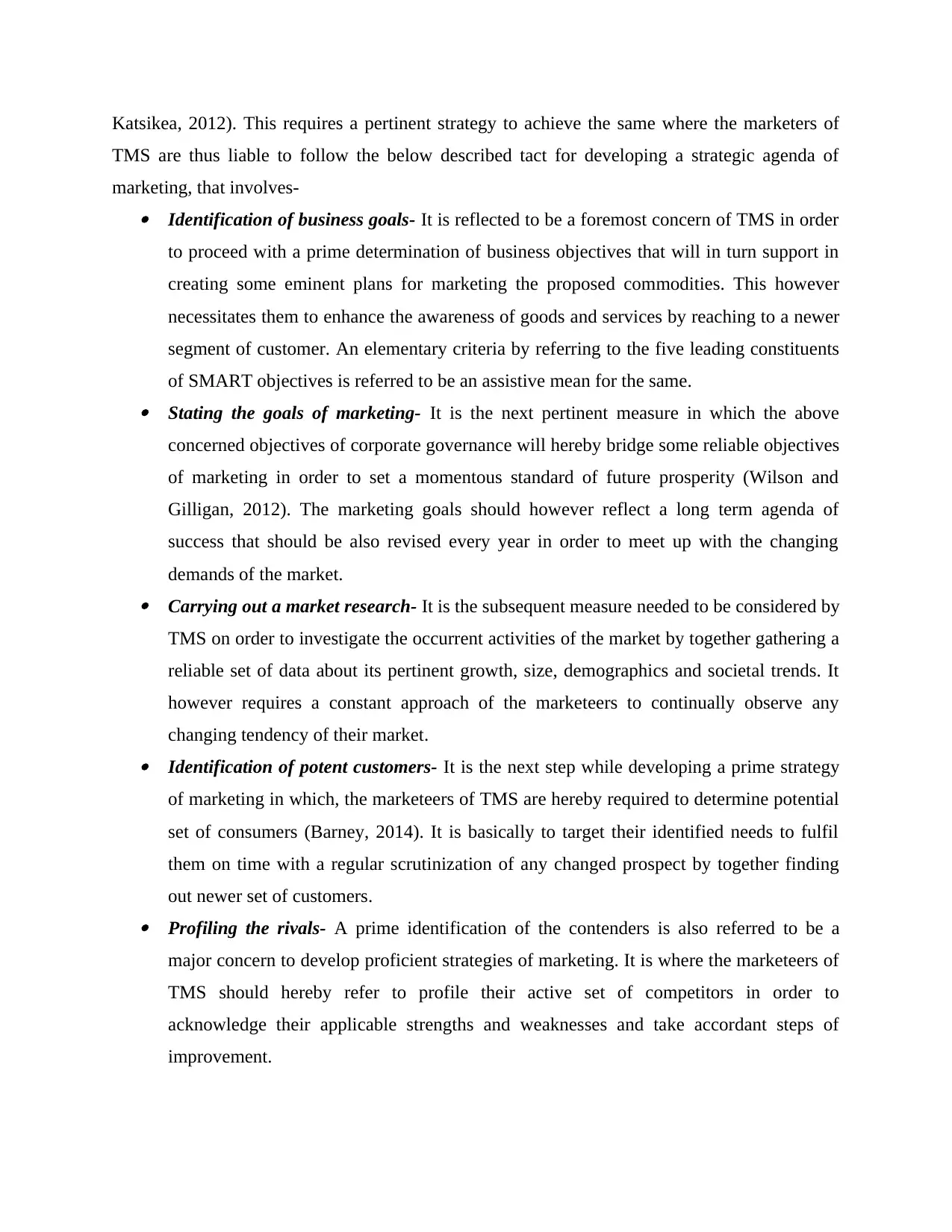
Katsikea, 2012). This requires a pertinent strategy to achieve the same where the marketers of
TMS are thus liable to follow the below described tact for developing a strategic agenda of
marketing, that involves- Identification of business goals- It is reflected to be a foremost concern of TMS in order
to proceed with a prime determination of business objectives that will in turn support in
creating some eminent plans for marketing the proposed commodities. This however
necessitates them to enhance the awareness of goods and services by reaching to a newer
segment of customer. An elementary criteria by referring to the five leading constituents
of SMART objectives is referred to be an assistive mean for the same. Stating the goals of marketing- It is the next pertinent measure in which the above
concerned objectives of corporate governance will hereby bridge some reliable objectives
of marketing in order to set a momentous standard of future prosperity (Wilson and
Gilligan, 2012). The marketing goals should however reflect a long term agenda of
success that should be also revised every year in order to meet up with the changing
demands of the market. Carrying out a market research- It is the subsequent measure needed to be considered by
TMS on order to investigate the occurrent activities of the market by together gathering a
reliable set of data about its pertinent growth, size, demographics and societal trends. It
however requires a constant approach of the marketeers to continually observe any
changing tendency of their market. Identification of potent customers- It is the next step while developing a prime strategy
of marketing in which, the marketeers of TMS are hereby required to determine potential
set of consumers (Barney, 2014). It is basically to target their identified needs to fulfil
them on time with a regular scrutinization of any changed prospect by together finding
out newer set of customers. Profiling the rivals- A prime identification of the contenders is also referred to be a
major concern to develop proficient strategies of marketing. It is where the marketeers of
TMS should hereby refer to profile their active set of competitors in order to
acknowledge their applicable strengths and weaknesses and take accordant steps of
improvement.
TMS are thus liable to follow the below described tact for developing a strategic agenda of
marketing, that involves- Identification of business goals- It is reflected to be a foremost concern of TMS in order
to proceed with a prime determination of business objectives that will in turn support in
creating some eminent plans for marketing the proposed commodities. This however
necessitates them to enhance the awareness of goods and services by reaching to a newer
segment of customer. An elementary criteria by referring to the five leading constituents
of SMART objectives is referred to be an assistive mean for the same. Stating the goals of marketing- It is the next pertinent measure in which the above
concerned objectives of corporate governance will hereby bridge some reliable objectives
of marketing in order to set a momentous standard of future prosperity (Wilson and
Gilligan, 2012). The marketing goals should however reflect a long term agenda of
success that should be also revised every year in order to meet up with the changing
demands of the market. Carrying out a market research- It is the subsequent measure needed to be considered by
TMS on order to investigate the occurrent activities of the market by together gathering a
reliable set of data about its pertinent growth, size, demographics and societal trends. It
however requires a constant approach of the marketeers to continually observe any
changing tendency of their market. Identification of potent customers- It is the next step while developing a prime strategy
of marketing in which, the marketeers of TMS are hereby required to determine potential
set of consumers (Barney, 2014). It is basically to target their identified needs to fulfil
them on time with a regular scrutinization of any changed prospect by together finding
out newer set of customers. Profiling the rivals- A prime identification of the contenders is also referred to be a
major concern to develop proficient strategies of marketing. It is where the marketeers of
TMS should hereby refer to profile their active set of competitors in order to
acknowledge their applicable strengths and weaknesses and take accordant steps of
improvement.
⊘ This is a preview!⊘
Do you want full access?
Subscribe today to unlock all pages.

Trusted by 1+ million students worldwide
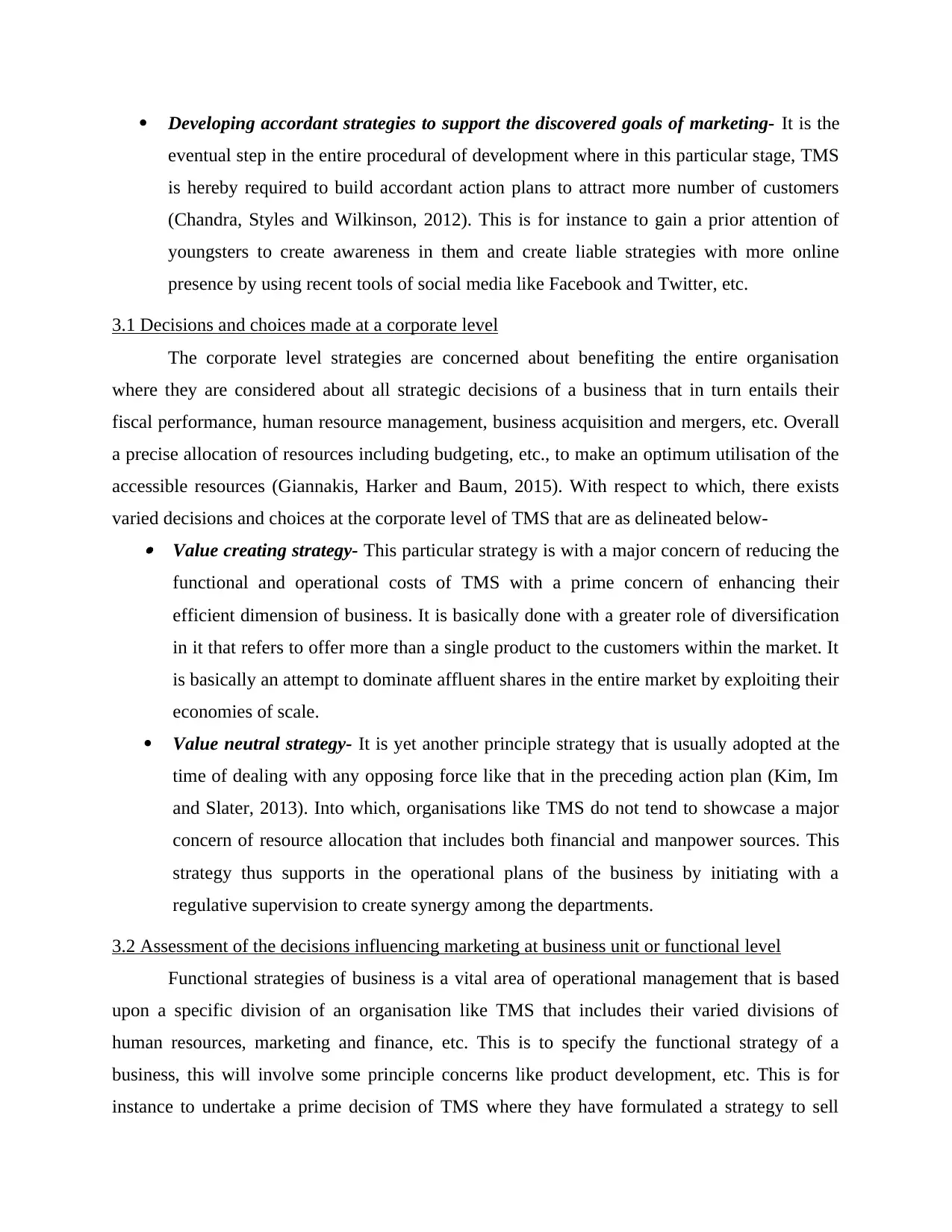
Developing accordant strategies to support the discovered goals of marketing- It is the
eventual step in the entire procedural of development where in this particular stage, TMS
is hereby required to build accordant action plans to attract more number of customers
(Chandra, Styles and Wilkinson, 2012). This is for instance to gain a prior attention of
youngsters to create awareness in them and create liable strategies with more online
presence by using recent tools of social media like Facebook and Twitter, etc.
3.1 Decisions and choices made at a corporate level
The corporate level strategies are concerned about benefiting the entire organisation
where they are considered about all strategic decisions of a business that in turn entails their
fiscal performance, human resource management, business acquisition and mergers, etc. Overall
a precise allocation of resources including budgeting, etc., to make an optimum utilisation of the
accessible resources (Giannakis, Harker and Baum, 2015). With respect to which, there exists
varied decisions and choices at the corporate level of TMS that are as delineated below- Value creating strategy- This particular strategy is with a major concern of reducing the
functional and operational costs of TMS with a prime concern of enhancing their
efficient dimension of business. It is basically done with a greater role of diversification
in it that refers to offer more than a single product to the customers within the market. It
is basically an attempt to dominate affluent shares in the entire market by exploiting their
economies of scale.
Value neutral strategy- It is yet another principle strategy that is usually adopted at the
time of dealing with any opposing force like that in the preceding action plan (Kim, Im
and Slater, 2013). Into which, organisations like TMS do not tend to showcase a major
concern of resource allocation that includes both financial and manpower sources. This
strategy thus supports in the operational plans of the business by initiating with a
regulative supervision to create synergy among the departments.
3.2 Assessment of the decisions influencing marketing at business unit or functional level
Functional strategies of business is a vital area of operational management that is based
upon a specific division of an organisation like TMS that includes their varied divisions of
human resources, marketing and finance, etc. This is to specify the functional strategy of a
business, this will involve some principle concerns like product development, etc. This is for
instance to undertake a prime decision of TMS where they have formulated a strategy to sell
eventual step in the entire procedural of development where in this particular stage, TMS
is hereby required to build accordant action plans to attract more number of customers
(Chandra, Styles and Wilkinson, 2012). This is for instance to gain a prior attention of
youngsters to create awareness in them and create liable strategies with more online
presence by using recent tools of social media like Facebook and Twitter, etc.
3.1 Decisions and choices made at a corporate level
The corporate level strategies are concerned about benefiting the entire organisation
where they are considered about all strategic decisions of a business that in turn entails their
fiscal performance, human resource management, business acquisition and mergers, etc. Overall
a precise allocation of resources including budgeting, etc., to make an optimum utilisation of the
accessible resources (Giannakis, Harker and Baum, 2015). With respect to which, there exists
varied decisions and choices at the corporate level of TMS that are as delineated below- Value creating strategy- This particular strategy is with a major concern of reducing the
functional and operational costs of TMS with a prime concern of enhancing their
efficient dimension of business. It is basically done with a greater role of diversification
in it that refers to offer more than a single product to the customers within the market. It
is basically an attempt to dominate affluent shares in the entire market by exploiting their
economies of scale.
Value neutral strategy- It is yet another principle strategy that is usually adopted at the
time of dealing with any opposing force like that in the preceding action plan (Kim, Im
and Slater, 2013). Into which, organisations like TMS do not tend to showcase a major
concern of resource allocation that includes both financial and manpower sources. This
strategy thus supports in the operational plans of the business by initiating with a
regulative supervision to create synergy among the departments.
3.2 Assessment of the decisions influencing marketing at business unit or functional level
Functional strategies of business is a vital area of operational management that is based
upon a specific division of an organisation like TMS that includes their varied divisions of
human resources, marketing and finance, etc. This is to specify the functional strategy of a
business, this will involve some principle concerns like product development, etc. This is for
instance to undertake a prime decision of TMS where they have formulated a strategy to sell
Paraphrase This Document
Need a fresh take? Get an instant paraphrase of this document with our AI Paraphraser
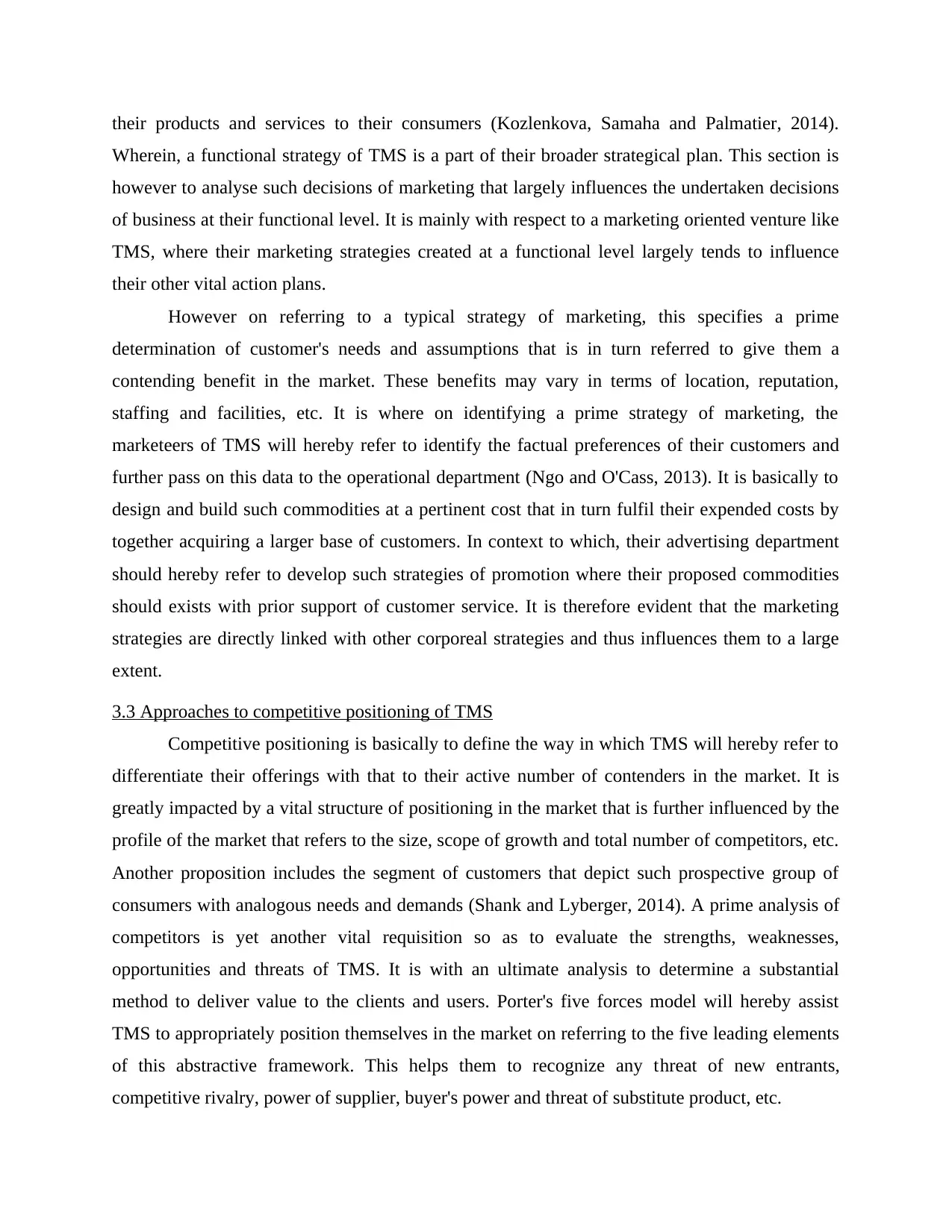
their products and services to their consumers (Kozlenkova, Samaha and Palmatier, 2014).
Wherein, a functional strategy of TMS is a part of their broader strategical plan. This section is
however to analyse such decisions of marketing that largely influences the undertaken decisions
of business at their functional level. It is mainly with respect to a marketing oriented venture like
TMS, where their marketing strategies created at a functional level largely tends to influence
their other vital action plans.
However on referring to a typical strategy of marketing, this specifies a prime
determination of customer's needs and assumptions that is in turn referred to give them a
contending benefit in the market. These benefits may vary in terms of location, reputation,
staffing and facilities, etc. It is where on identifying a prime strategy of marketing, the
marketeers of TMS will hereby refer to identify the factual preferences of their customers and
further pass on this data to the operational department (Ngo and O'Cass, 2013). It is basically to
design and build such commodities at a pertinent cost that in turn fulfil their expended costs by
together acquiring a larger base of customers. In context to which, their advertising department
should hereby refer to develop such strategies of promotion where their proposed commodities
should exists with prior support of customer service. It is therefore evident that the marketing
strategies are directly linked with other corporeal strategies and thus influences them to a large
extent.
3.3 Approaches to competitive positioning of TMS
Competitive positioning is basically to define the way in which TMS will hereby refer to
differentiate their offerings with that to their active number of contenders in the market. It is
greatly impacted by a vital structure of positioning in the market that is further influenced by the
profile of the market that refers to the size, scope of growth and total number of competitors, etc.
Another proposition includes the segment of customers that depict such prospective group of
consumers with analogous needs and demands (Shank and Lyberger, 2014). A prime analysis of
competitors is yet another vital requisition so as to evaluate the strengths, weaknesses,
opportunities and threats of TMS. It is with an ultimate analysis to determine a substantial
method to deliver value to the clients and users. Porter's five forces model will hereby assist
TMS to appropriately position themselves in the market on referring to the five leading elements
of this abstractive framework. This helps them to recognize any threat of new entrants,
competitive rivalry, power of supplier, buyer's power and threat of substitute product, etc.
Wherein, a functional strategy of TMS is a part of their broader strategical plan. This section is
however to analyse such decisions of marketing that largely influences the undertaken decisions
of business at their functional level. It is mainly with respect to a marketing oriented venture like
TMS, where their marketing strategies created at a functional level largely tends to influence
their other vital action plans.
However on referring to a typical strategy of marketing, this specifies a prime
determination of customer's needs and assumptions that is in turn referred to give them a
contending benefit in the market. These benefits may vary in terms of location, reputation,
staffing and facilities, etc. It is where on identifying a prime strategy of marketing, the
marketeers of TMS will hereby refer to identify the factual preferences of their customers and
further pass on this data to the operational department (Ngo and O'Cass, 2013). It is basically to
design and build such commodities at a pertinent cost that in turn fulfil their expended costs by
together acquiring a larger base of customers. In context to which, their advertising department
should hereby refer to develop such strategies of promotion where their proposed commodities
should exists with prior support of customer service. It is therefore evident that the marketing
strategies are directly linked with other corporeal strategies and thus influences them to a large
extent.
3.3 Approaches to competitive positioning of TMS
Competitive positioning is basically to define the way in which TMS will hereby refer to
differentiate their offerings with that to their active number of contenders in the market. It is
greatly impacted by a vital structure of positioning in the market that is further influenced by the
profile of the market that refers to the size, scope of growth and total number of competitors, etc.
Another proposition includes the segment of customers that depict such prospective group of
consumers with analogous needs and demands (Shank and Lyberger, 2014). A prime analysis of
competitors is yet another vital requisition so as to evaluate the strengths, weaknesses,
opportunities and threats of TMS. It is with an ultimate analysis to determine a substantial
method to deliver value to the clients and users. Porter's five forces model will hereby assist
TMS to appropriately position themselves in the market on referring to the five leading elements
of this abstractive framework. This helps them to recognize any threat of new entrants,
competitive rivalry, power of supplier, buyer's power and threat of substitute product, etc.
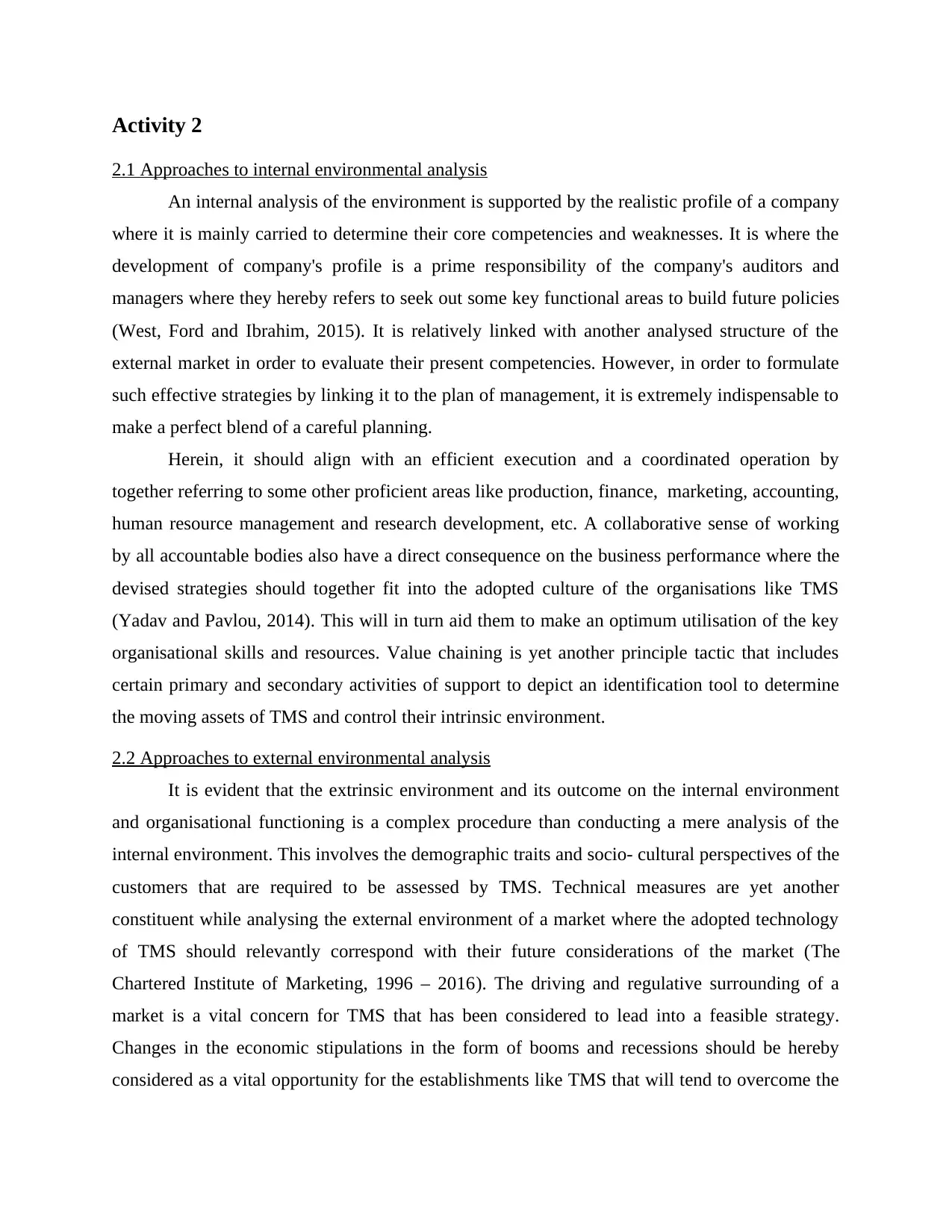
Activity 2
2.1 Approaches to internal environmental analysis
An internal analysis of the environment is supported by the realistic profile of a company
where it is mainly carried to determine their core competencies and weaknesses. It is where the
development of company's profile is a prime responsibility of the company's auditors and
managers where they hereby refers to seek out some key functional areas to build future policies
(West, Ford and Ibrahim, 2015). It is relatively linked with another analysed structure of the
external market in order to evaluate their present competencies. However, in order to formulate
such effective strategies by linking it to the plan of management, it is extremely indispensable to
make a perfect blend of a careful planning.
Herein, it should align with an efficient execution and a coordinated operation by
together referring to some other proficient areas like production, finance, marketing, accounting,
human resource management and research development, etc. A collaborative sense of working
by all accountable bodies also have a direct consequence on the business performance where the
devised strategies should together fit into the adopted culture of the organisations like TMS
(Yadav and Pavlou, 2014). This will in turn aid them to make an optimum utilisation of the key
organisational skills and resources. Value chaining is yet another principle tactic that includes
certain primary and secondary activities of support to depict an identification tool to determine
the moving assets of TMS and control their intrinsic environment.
2.2 Approaches to external environmental analysis
It is evident that the extrinsic environment and its outcome on the internal environment
and organisational functioning is a complex procedure than conducting a mere analysis of the
internal environment. This involves the demographic traits and socio- cultural perspectives of the
customers that are required to be assessed by TMS. Technical measures are yet another
constituent while analysing the external environment of a market where the adopted technology
of TMS should relevantly correspond with their future considerations of the market (The
Chartered Institute of Marketing, 1996 – 2016). The driving and regulative surrounding of a
market is a vital concern for TMS that has been considered to lead into a feasible strategy.
Changes in the economic stipulations in the form of booms and recessions should be hereby
considered as a vital opportunity for the establishments like TMS that will tend to overcome the
2.1 Approaches to internal environmental analysis
An internal analysis of the environment is supported by the realistic profile of a company
where it is mainly carried to determine their core competencies and weaknesses. It is where the
development of company's profile is a prime responsibility of the company's auditors and
managers where they hereby refers to seek out some key functional areas to build future policies
(West, Ford and Ibrahim, 2015). It is relatively linked with another analysed structure of the
external market in order to evaluate their present competencies. However, in order to formulate
such effective strategies by linking it to the plan of management, it is extremely indispensable to
make a perfect blend of a careful planning.
Herein, it should align with an efficient execution and a coordinated operation by
together referring to some other proficient areas like production, finance, marketing, accounting,
human resource management and research development, etc. A collaborative sense of working
by all accountable bodies also have a direct consequence on the business performance where the
devised strategies should together fit into the adopted culture of the organisations like TMS
(Yadav and Pavlou, 2014). This will in turn aid them to make an optimum utilisation of the key
organisational skills and resources. Value chaining is yet another principle tactic that includes
certain primary and secondary activities of support to depict an identification tool to determine
the moving assets of TMS and control their intrinsic environment.
2.2 Approaches to external environmental analysis
It is evident that the extrinsic environment and its outcome on the internal environment
and organisational functioning is a complex procedure than conducting a mere analysis of the
internal environment. This involves the demographic traits and socio- cultural perspectives of the
customers that are required to be assessed by TMS. Technical measures are yet another
constituent while analysing the external environment of a market where the adopted technology
of TMS should relevantly correspond with their future considerations of the market (The
Chartered Institute of Marketing, 1996 – 2016). The driving and regulative surrounding of a
market is a vital concern for TMS that has been considered to lead into a feasible strategy.
Changes in the economic stipulations in the form of booms and recessions should be hereby
considered as a vital opportunity for the establishments like TMS that will tend to overcome the
⊘ This is a preview!⊘
Do you want full access?
Subscribe today to unlock all pages.

Trusted by 1+ million students worldwide
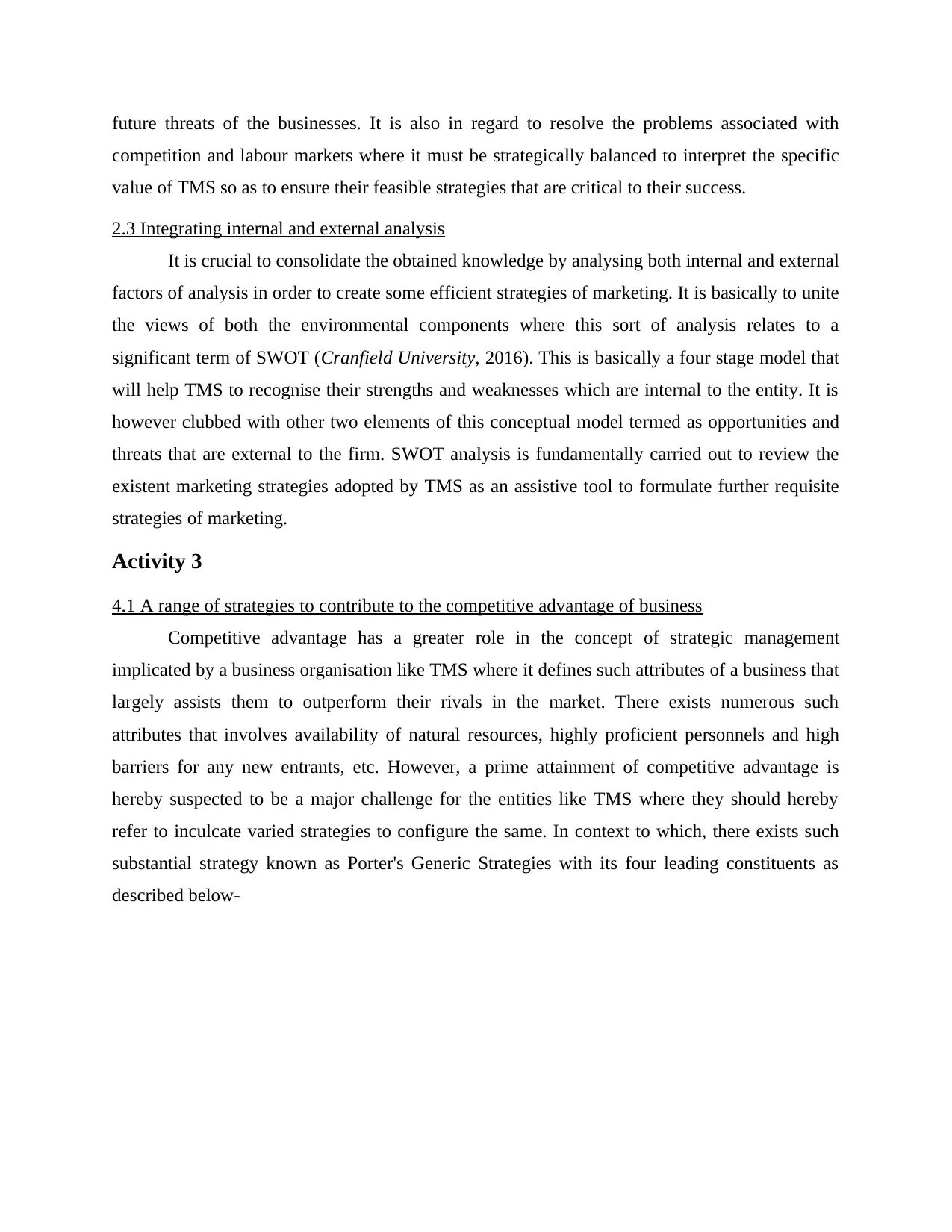
future threats of the businesses. It is also in regard to resolve the problems associated with
competition and labour markets where it must be strategically balanced to interpret the specific
value of TMS so as to ensure their feasible strategies that are critical to their success.
2.3 Integrating internal and external analysis
It is crucial to consolidate the obtained knowledge by analysing both internal and external
factors of analysis in order to create some efficient strategies of marketing. It is basically to unite
the views of both the environmental components where this sort of analysis relates to a
significant term of SWOT (Cranfield University, 2016). This is basically a four stage model that
will help TMS to recognise their strengths and weaknesses which are internal to the entity. It is
however clubbed with other two elements of this conceptual model termed as opportunities and
threats that are external to the firm. SWOT analysis is fundamentally carried out to review the
existent marketing strategies adopted by TMS as an assistive tool to formulate further requisite
strategies of marketing.
Activity 3
4.1 A range of strategies to contribute to the competitive advantage of business
Competitive advantage has a greater role in the concept of strategic management
implicated by a business organisation like TMS where it defines such attributes of a business that
largely assists them to outperform their rivals in the market. There exists numerous such
attributes that involves availability of natural resources, highly proficient personnels and high
barriers for any new entrants, etc. However, a prime attainment of competitive advantage is
hereby suspected to be a major challenge for the entities like TMS where they should hereby
refer to inculcate varied strategies to configure the same. In context to which, there exists such
substantial strategy known as Porter's Generic Strategies with its four leading constituents as
described below-
competition and labour markets where it must be strategically balanced to interpret the specific
value of TMS so as to ensure their feasible strategies that are critical to their success.
2.3 Integrating internal and external analysis
It is crucial to consolidate the obtained knowledge by analysing both internal and external
factors of analysis in order to create some efficient strategies of marketing. It is basically to unite
the views of both the environmental components where this sort of analysis relates to a
significant term of SWOT (Cranfield University, 2016). This is basically a four stage model that
will help TMS to recognise their strengths and weaknesses which are internal to the entity. It is
however clubbed with other two elements of this conceptual model termed as opportunities and
threats that are external to the firm. SWOT analysis is fundamentally carried out to review the
existent marketing strategies adopted by TMS as an assistive tool to formulate further requisite
strategies of marketing.
Activity 3
4.1 A range of strategies to contribute to the competitive advantage of business
Competitive advantage has a greater role in the concept of strategic management
implicated by a business organisation like TMS where it defines such attributes of a business that
largely assists them to outperform their rivals in the market. There exists numerous such
attributes that involves availability of natural resources, highly proficient personnels and high
barriers for any new entrants, etc. However, a prime attainment of competitive advantage is
hereby suspected to be a major challenge for the entities like TMS where they should hereby
refer to inculcate varied strategies to configure the same. In context to which, there exists such
substantial strategy known as Porter's Generic Strategies with its four leading constituents as
described below-
Paraphrase This Document
Need a fresh take? Get an instant paraphrase of this document with our AI Paraphraser
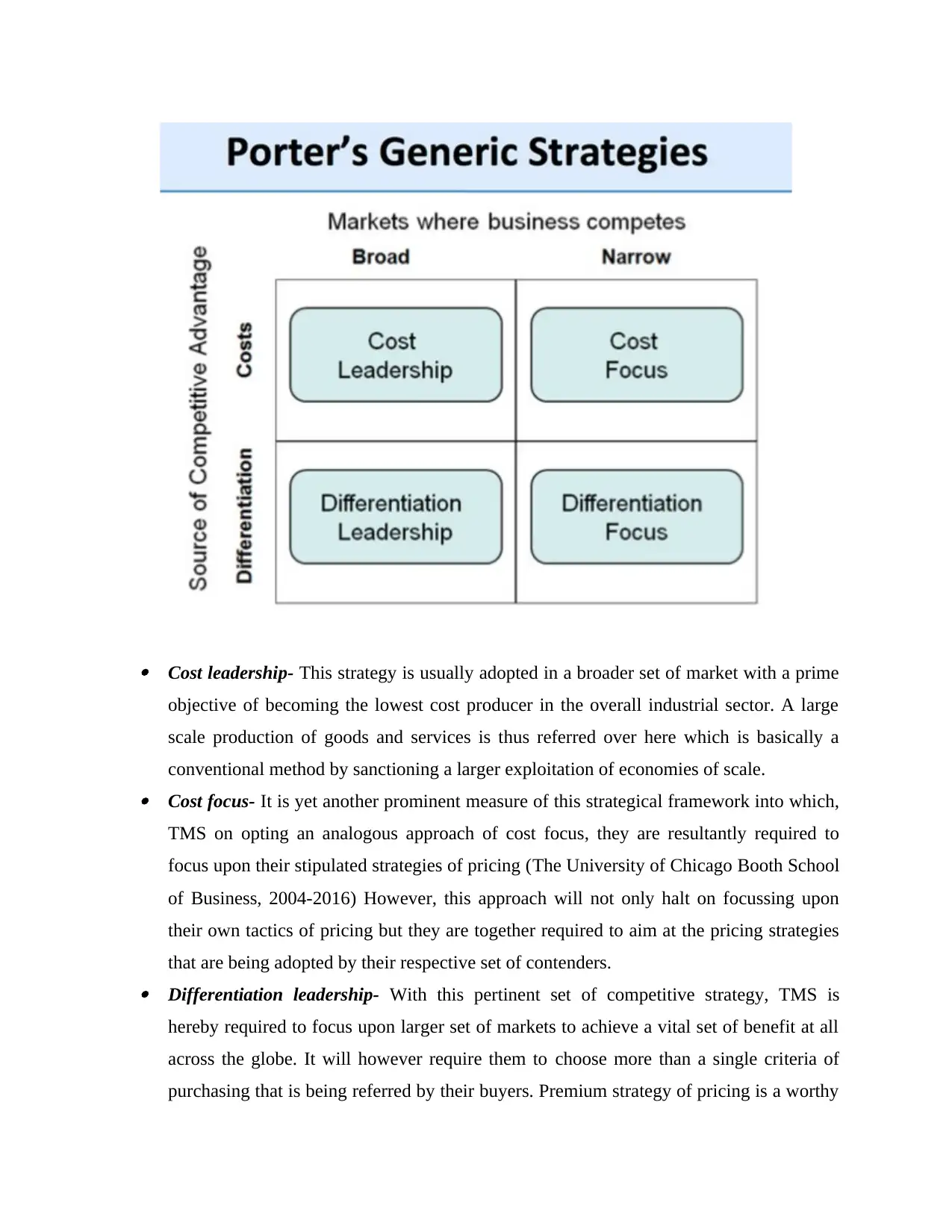
Cost leadership- This strategy is usually adopted in a broader set of market with a prime
objective of becoming the lowest cost producer in the overall industrial sector. A large
scale production of goods and services is thus referred over here which is basically a
conventional method by sanctioning a larger exploitation of economies of scale. Cost focus- It is yet another prominent measure of this strategical framework into which,
TMS on opting an analogous approach of cost focus, they are resultantly required to
focus upon their stipulated strategies of pricing (The University of Chicago Booth School
of Business, 2004-2016) However, this approach will not only halt on focussing upon
their own tactics of pricing but they are together required to aim at the pricing strategies
that are being adopted by their respective set of contenders. Differentiation leadership- With this pertinent set of competitive strategy, TMS is
hereby required to focus upon larger set of markets to achieve a vital set of benefit at all
across the globe. It will however require them to choose more than a single criteria of
purchasing that is being referred by their buyers. Premium strategy of pricing is a worthy
objective of becoming the lowest cost producer in the overall industrial sector. A large
scale production of goods and services is thus referred over here which is basically a
conventional method by sanctioning a larger exploitation of economies of scale. Cost focus- It is yet another prominent measure of this strategical framework into which,
TMS on opting an analogous approach of cost focus, they are resultantly required to
focus upon their stipulated strategies of pricing (The University of Chicago Booth School
of Business, 2004-2016) However, this approach will not only halt on focussing upon
their own tactics of pricing but they are together required to aim at the pricing strategies
that are being adopted by their respective set of contenders. Differentiation leadership- With this pertinent set of competitive strategy, TMS is
hereby required to focus upon larger set of markets to achieve a vital set of benefit at all
across the globe. It will however require them to choose more than a single criteria of
purchasing that is being referred by their buyers. Premium strategy of pricing is a worthy
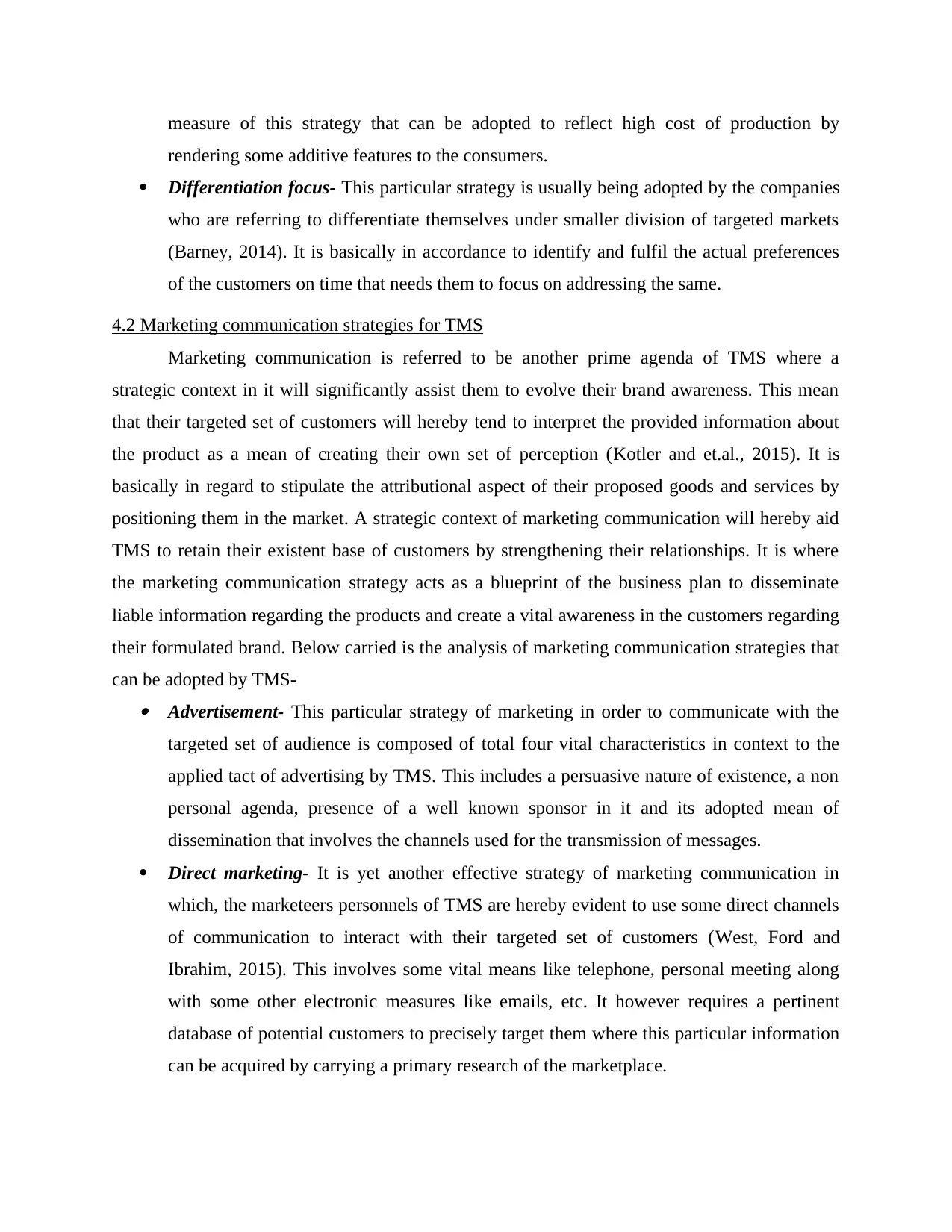
measure of this strategy that can be adopted to reflect high cost of production by
rendering some additive features to the consumers.
Differentiation focus- This particular strategy is usually being adopted by the companies
who are referring to differentiate themselves under smaller division of targeted markets
(Barney, 2014). It is basically in accordance to identify and fulfil the actual preferences
of the customers on time that needs them to focus on addressing the same.
4.2 Marketing communication strategies for TMS
Marketing communication is referred to be another prime agenda of TMS where a
strategic context in it will significantly assist them to evolve their brand awareness. This mean
that their targeted set of customers will hereby tend to interpret the provided information about
the product as a mean of creating their own set of perception (Kotler and et.al., 2015). It is
basically in regard to stipulate the attributional aspect of their proposed goods and services by
positioning them in the market. A strategic context of marketing communication will hereby aid
TMS to retain their existent base of customers by strengthening their relationships. It is where
the marketing communication strategy acts as a blueprint of the business plan to disseminate
liable information regarding the products and create a vital awareness in the customers regarding
their formulated brand. Below carried is the analysis of marketing communication strategies that
can be adopted by TMS- Advertisement- This particular strategy of marketing in order to communicate with the
targeted set of audience is composed of total four vital characteristics in context to the
applied tact of advertising by TMS. This includes a persuasive nature of existence, a non
personal agenda, presence of a well known sponsor in it and its adopted mean of
dissemination that involves the channels used for the transmission of messages.
Direct marketing- It is yet another effective strategy of marketing communication in
which, the marketeers personnels of TMS are hereby evident to use some direct channels
of communication to interact with their targeted set of customers (West, Ford and
Ibrahim, 2015). This involves some vital means like telephone, personal meeting along
with some other electronic measures like emails, etc. It however requires a pertinent
database of potential customers to precisely target them where this particular information
can be acquired by carrying a primary research of the marketplace.
rendering some additive features to the consumers.
Differentiation focus- This particular strategy is usually being adopted by the companies
who are referring to differentiate themselves under smaller division of targeted markets
(Barney, 2014). It is basically in accordance to identify and fulfil the actual preferences
of the customers on time that needs them to focus on addressing the same.
4.2 Marketing communication strategies for TMS
Marketing communication is referred to be another prime agenda of TMS where a
strategic context in it will significantly assist them to evolve their brand awareness. This mean
that their targeted set of customers will hereby tend to interpret the provided information about
the product as a mean of creating their own set of perception (Kotler and et.al., 2015). It is
basically in regard to stipulate the attributional aspect of their proposed goods and services by
positioning them in the market. A strategic context of marketing communication will hereby aid
TMS to retain their existent base of customers by strengthening their relationships. It is where
the marketing communication strategy acts as a blueprint of the business plan to disseminate
liable information regarding the products and create a vital awareness in the customers regarding
their formulated brand. Below carried is the analysis of marketing communication strategies that
can be adopted by TMS- Advertisement- This particular strategy of marketing in order to communicate with the
targeted set of audience is composed of total four vital characteristics in context to the
applied tact of advertising by TMS. This includes a persuasive nature of existence, a non
personal agenda, presence of a well known sponsor in it and its adopted mean of
dissemination that involves the channels used for the transmission of messages.
Direct marketing- It is yet another effective strategy of marketing communication in
which, the marketeers personnels of TMS are hereby evident to use some direct channels
of communication to interact with their targeted set of customers (West, Ford and
Ibrahim, 2015). This involves some vital means like telephone, personal meeting along
with some other electronic measures like emails, etc. It however requires a pertinent
database of potential customers to precisely target them where this particular information
can be acquired by carrying a primary research of the marketplace.
⊘ This is a preview!⊘
Do you want full access?
Subscribe today to unlock all pages.

Trusted by 1+ million students worldwide
1 out of 17
Related Documents
Your All-in-One AI-Powered Toolkit for Academic Success.
+13062052269
info@desklib.com
Available 24*7 on WhatsApp / Email
![[object Object]](/_next/static/media/star-bottom.7253800d.svg)
Unlock your academic potential
Copyright © 2020–2025 A2Z Services. All Rights Reserved. Developed and managed by ZUCOL.





